Development of a Geospatial Data-Based Methodology for Stormwater Management in Urban Areas Using Freely-Available Software
Abstract
1. Introduction
- To develop a new methodology to allow practitioners and academics to combine GIS and stormwater management tools in order to assess the drainage network capacity accurately in urban catchments.
- To measure the impact on a pre-existing hydrology of rural sub-catchments flowing into urban catchments in areas under development.
2. Materials and Methods
2.1. Location and Main Characteristics for the Case Study: Gijón (Spain)
- Previous stage. Originally, it was a rural area with agricultural land use until construction began in 2010.
- Development stage. Urban development with an associated increase in population.
- Final stage: Large commercial and service buildings (the neighbourhood has a commercial centre, several football fields and tennis courts, nurseries, and greenhouses, as well as multiple green areas and access roads) (Figure 1).
- East-bound: The AS-I highway
- North-bound: The A8 highway
- West-bound: The AS-246 national road to the west and “El Camino de la Perdiz” to the south.
2.2. Experimental Methodology
3. Results and Discussion
- A first scenario, taking into account the urbanised area without the rural sub-catchments surrounding it.
- A second scenario, considering the catchment as a whole including adjacent rural areas.
4. Conclusions
Author Contributions
Funding
Acknowledgments
Conflicts of Interest
References
- United Nations. World Urbanization Prospects: The 2014 Revision; Report ST/ESA/SER.A/366; Department of Economic and Social Affairs, Population Division, United Nations: New York, NY, USA, 2015. [Google Scholar]
- Rushton, B.T. Low-impact parking lot design reduces runoff and pollutant loads. J. Water Resour. Plan. Manag. 2001, 127, 172–179. [Google Scholar] [CrossRef]
- Suriya, S.; Mudgal, B.V. Impact of urbanization on flooding: The Thirusoolam sub watershed—A case study. J. Hydrol. 2012, 412–413, 210–219. [Google Scholar] [CrossRef]
- Leopold, L.B. Hydrology for Urban Land Planning—A Guidebook on the Hydrologic Effects of Urban Land Use; Circular 554; U.S. Geological Survey: Reston, VA, USA, 1968. Available online: https://pubs.usgs.gov/circ/1968/0554/report.pdf (accessed on 30 November 2017).
- De Keyser, W.; Gevaert, V.; Verdonck, F.; Nopens, I.; De Baets, B.; Vanrolleghem, P.A.; Mikkelsen, P.S.; Benedetti, L. Combining multimedia models with integrated urban water system models for micropollutants. Water Sci. Technol. 2010, 62, 1614–1622. [Google Scholar] [CrossRef] [PubMed]
- Walsh, C.J.; Roy, A.H.; Feminella, J.W.; Cottingham, P.D.; Groffman, P.M.; Morgan, R.P., II. The urban stream syndrome: Current knowledge and the search for a cure. J. N. Am. Benthol. Soc. 2005, 24, 706–723. [Google Scholar] [CrossRef]
- Gómez Valentín, M. Curso de Hidrología Urbana; Alfambra, Ed.; Departamento de Ing. Hidráulica, Marítima y Ambiental—Sección de Ing. Hidráulica e Hidrológica: Barcelona, España, 2008; pp. 123–134. ISBN 978-84-612-1514-0. [Google Scholar]
- Paul, D.; Mandla, V.R.; Singh, T. Quantifying and modeling of stream network using digital elevation models. Ain Shams Eng. J. 2017, 8, 311–321. [Google Scholar] [CrossRef]
- Rossman, L. Storm Water Management Model User’s Manual—Version 5.0; EPA: Washington, DC, USA, 2010. [Google Scholar]
- Sañudo-Fontaneda, L.A.; Jato-Espino, D.; Lashford, C.; Coupe, S.J. Simulation of the hydraulic performance of highway filter drains through laboratory models and stormwater management tools. Environ. Sci. Pollut. Res. 2018, 25, 19228–19237. [Google Scholar] [CrossRef] [PubMed]
- Kuhn, N.J.; Zhu, H. Gis-based modeling of runoff source areas and pathways. Geogr. Helv. 2008, 63, 48–57. [Google Scholar] [CrossRef]
- Trilles, S.; Díaz, L.; Huerta, J. Approach to facilitating geospatial data and metadata publication using a standard geoservice. ISPRS Int. J. Geo-Inf. 2017, 6, 126. [Google Scholar] [CrossRef]
- IDEE. Available online: http://www.idee.es/ (accessed on 30 November 2017).
- Rao, D.R.M.; Ahmed, Z. Selection of Drainage Network Using Raster GIS-A. Case Study. Int. J. Eng. Sci. Invent. 2013, 2, 35–40. [Google Scholar]
- Rai, P.K.; Chahar, B.R.; Dhanya, C.T. GIS-based SWMM model for simulating the catchment response to flood events. Hydrol. Res. 2017, 48, 384–394. [Google Scholar] [CrossRef]
- Kong, F.; Ban, Y.; Yin, H.; James, P.; Dronova, I. Modeling stormwater management at the city district level in response to changes in land use and low impact development. Environ. Model. Softw. 2017, 95, 132–142. [Google Scholar] [CrossRef]
- Jato Espino, D.; Sillanpää, N.; Charlesworth, S.M.; Andrés Doménech, I. Coupling GIS with Stormwater Modelling for the Location Prioritization and Hydrological Simulation of Permeable Pavements in Urban Catchments. Water 2016, 8, 451. [Google Scholar] [CrossRef]
- Ávila, H.; Amaris, G.; Buelvas, J. Identifying Potential Areas for SUDS Application in Consolidated Urban Watersheds Based on GIS. World Environ. Water Resour. Congr. 2016, 106–114. [Google Scholar] [CrossRef]
- Jato Espino, D.; Charlesworth, S.M.; Bayon, J.R.; Warwick, F. Rainfall-Runoff Simulations to Assess the Potential of SuDS for Mitigating Flooding in Highly Urbanized Catchments. Int. J. Environ. Res. Public Health 2016, 13, 149. [Google Scholar] [CrossRef] [PubMed]
- Ozdemir, H.; Sampson, C.C.; De Almeida, G.A.M.; Bates, P.D. Evaluating scale and roughness effects in urban flood modelling using terrestrial LIDAR data. Hydrol. Earth Syst. Sci. 2013, 17, 4015–4030. [Google Scholar] [CrossRef]
- Tsubaki, R.; Fujita, I. Unstructured grid generation using LiDAR data for urban flood inundation modelling. Hydrol. Process. 2010, 24, 1404–1420. [Google Scholar] [CrossRef]
- OpenTopograghy. Available online: http://www.opentopography.org/ (accessed on 18 December 2017).
- AEMET. Iberian Climate Areas. Available online: http://www.aemet.es/documentos/es/conocermas/publicaciones/Atlas-climatologico/Atlas.pdf (accessed on 30 November 2017).
- Spanish Standard for Drainage Design in Roads. Orden FOM/298/2016, de 15 de Febrero, por la que se Aprueba la Norma 5.2—IC Drenaje Superficial de la Instrucción de Carreteras. Available online: https://www.boe.es/buscar/doc.php?id=BOE-A-2016-2405 (accessed on 30 November 2017).
- OSGeo. Available online: http://www.osgeo.org/ (accessed on 30 November 2017).
- SAGA. Available online: www.saga-gis.org/ (accessed on 30 November 2017).
- GRASS GIS. Available online: https://grass.osgeo.org/ (accessed on 30 November 2017).
- PostgreSQL. Available online: https://www.postgresql.org/ (accessed on 30 November 2017).
- PostGIS. Available online: http://postgis.net/ (accessed on 30 November 2017).
- QGIS. Available online: http://www.qgis.org/ (accessed on 30 November 2017).
- SWMM. Available online: https://www.openswmm.org/ (accessed on 30 November 2017).
- GISWATER. Available online: https://www.giswater.org/ (accessed on 30 November 2017).
- AEMET. Available online: http://www.aemet.es/es/portada (accessed on 30 November 2017).
- IGN. Available online: http://www.ign.es/web/ign/portal (accessed on 30 November 2017).
- MAPAMA. Available online: http://www.mapama.gob.es/es/ (accessed on 30 November 2017).
- Flumen Institute. Calculation of the Project Rain from the Procedure of Alterning Blocks. Available online: http://www.flumen.upc.edu/es (accessed on 30 November 2017).
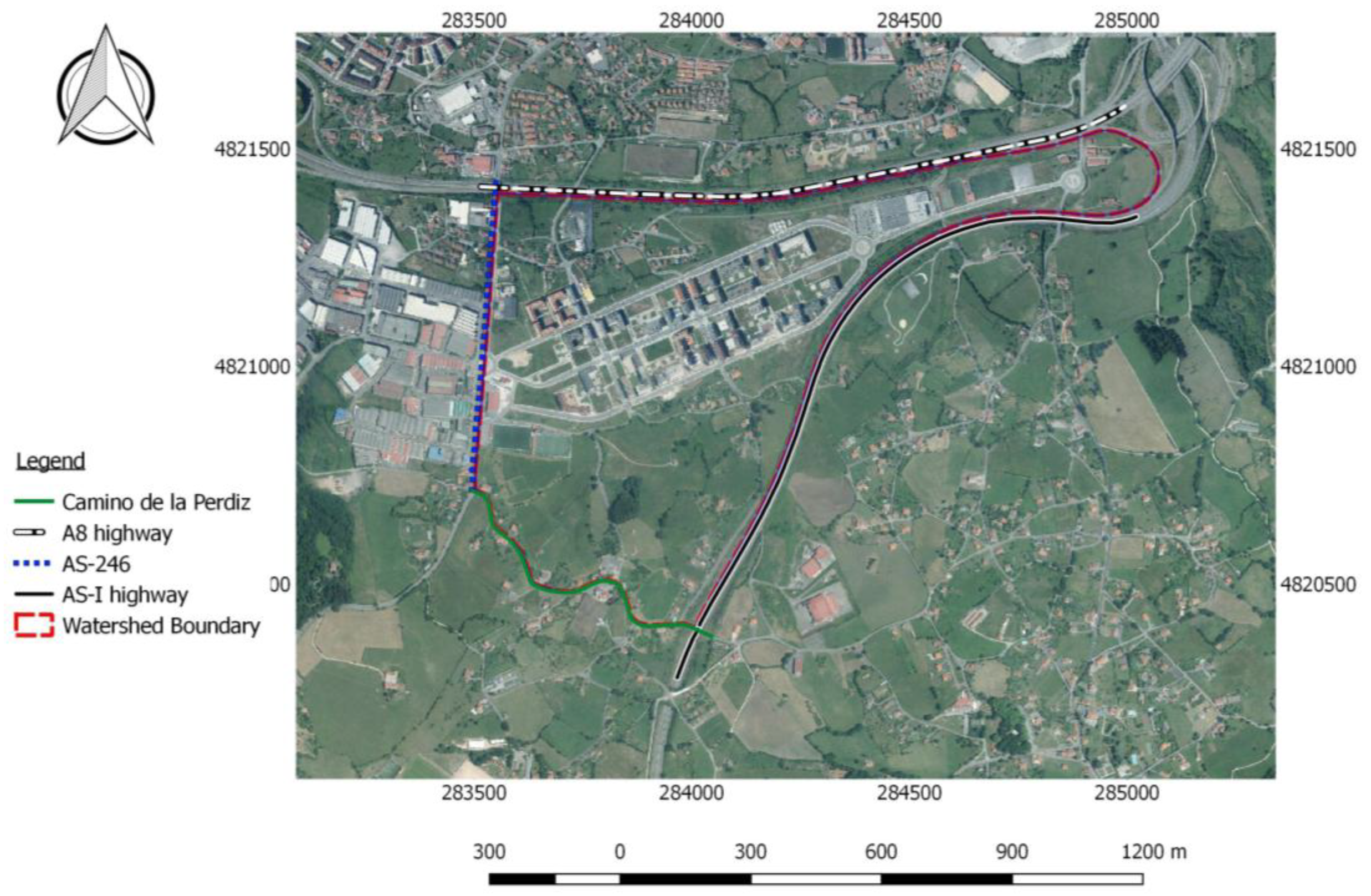
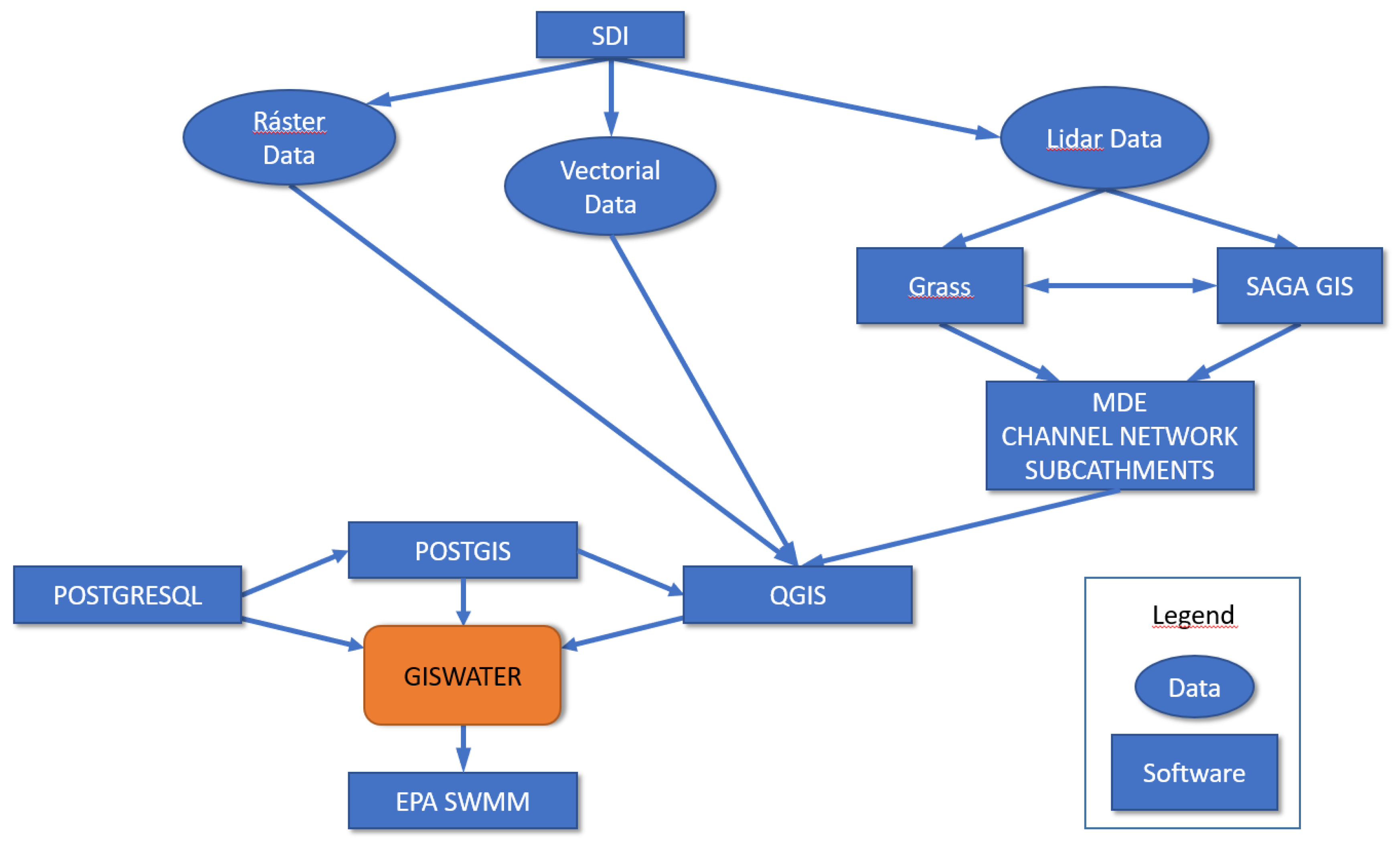
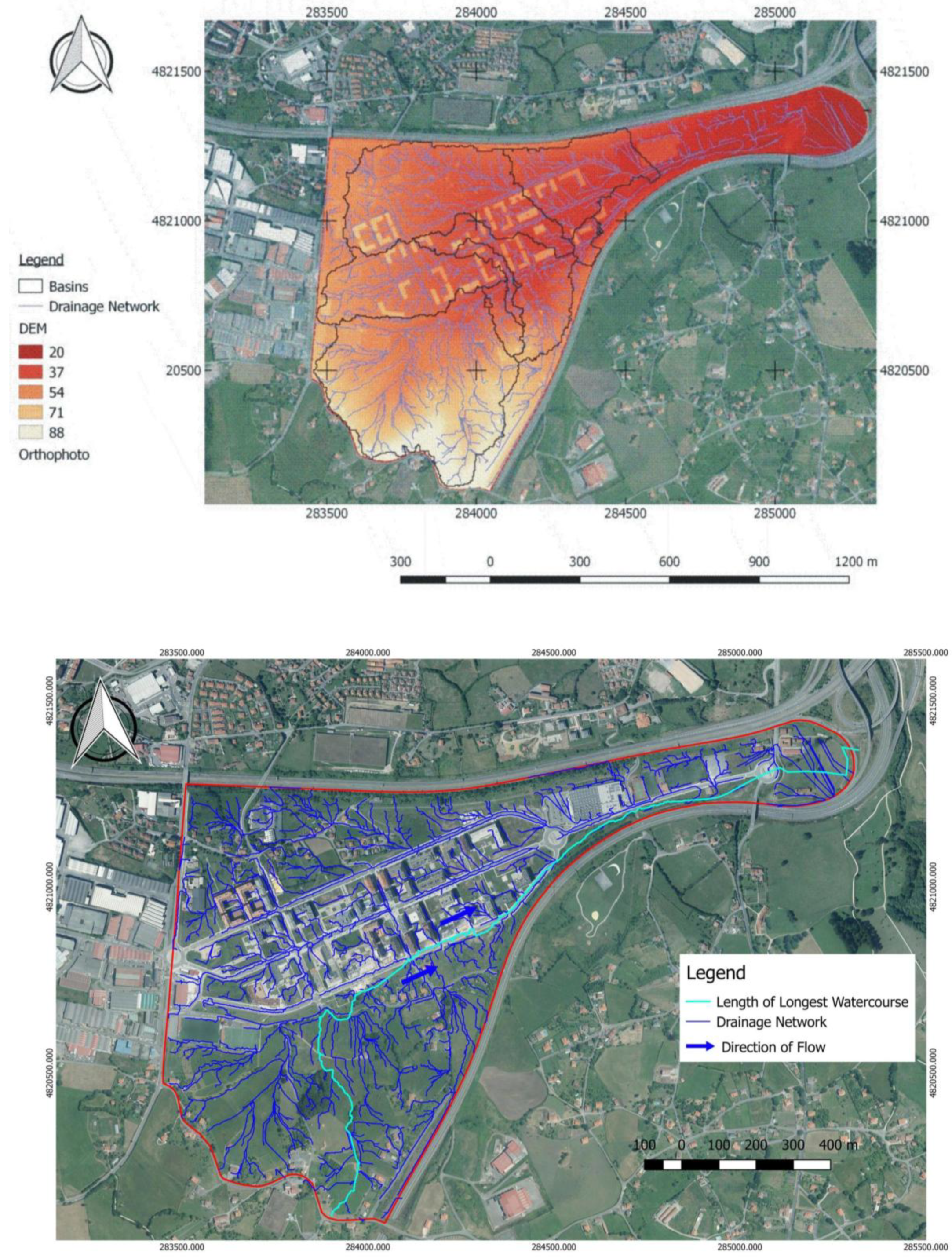
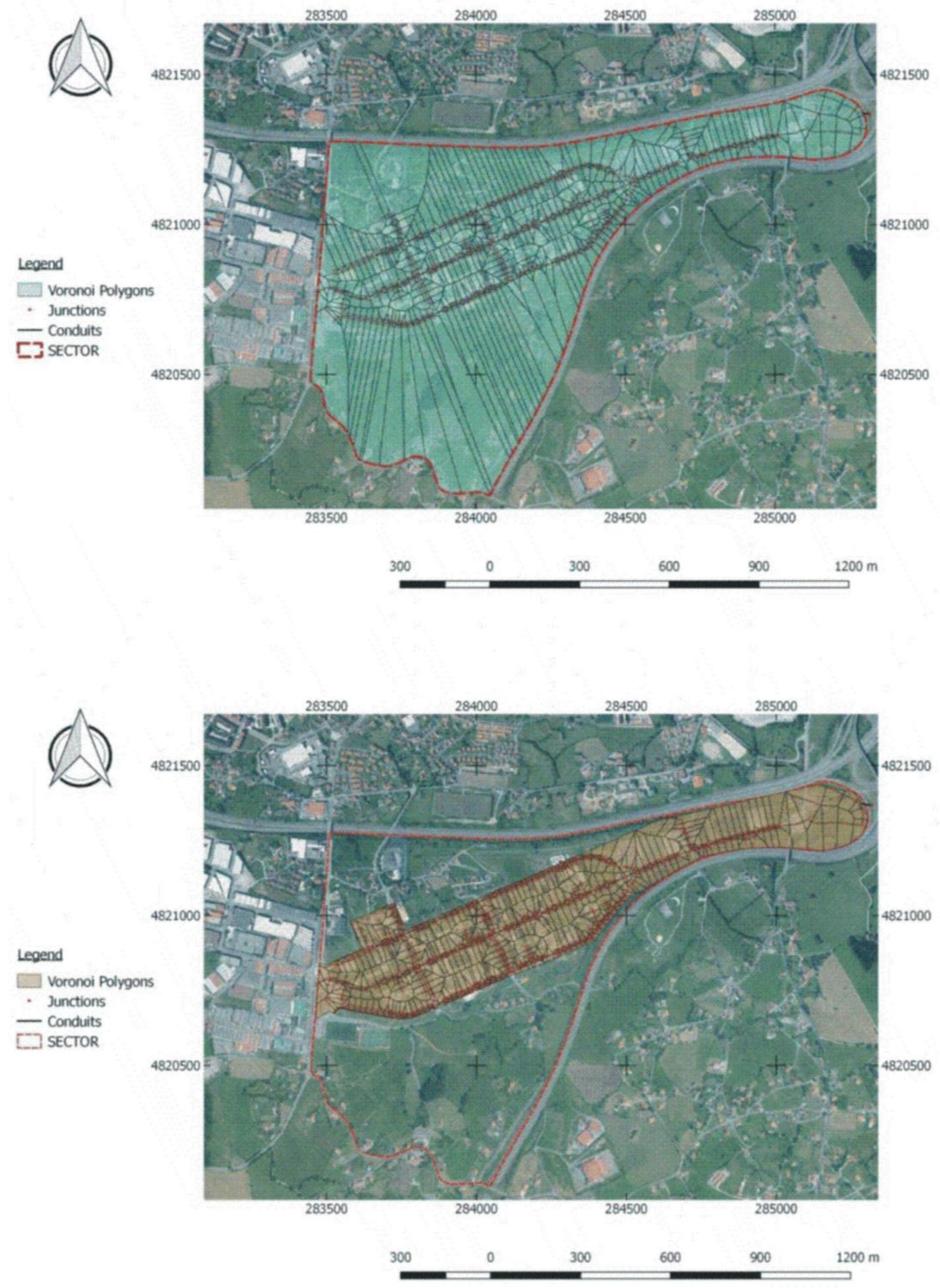
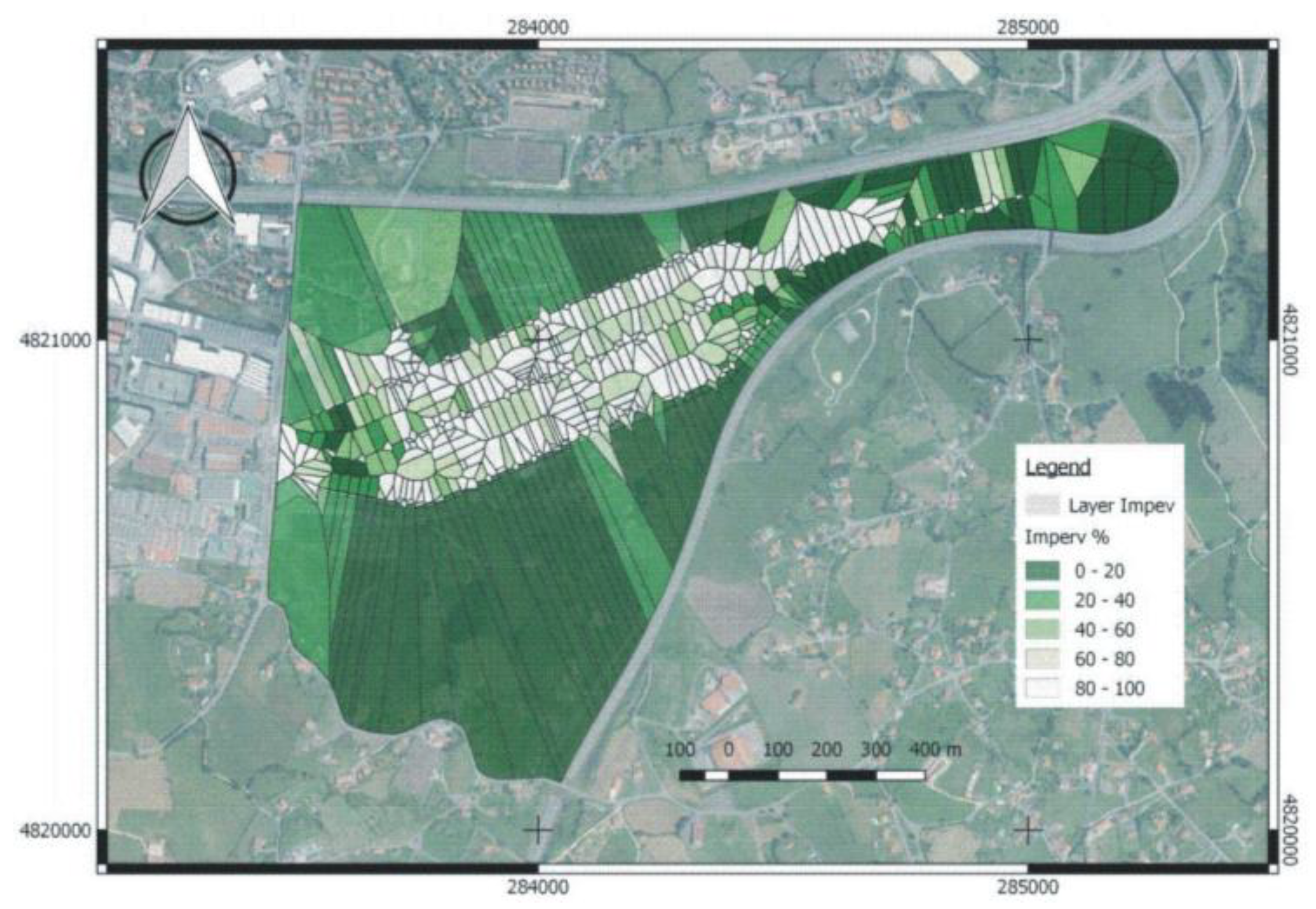
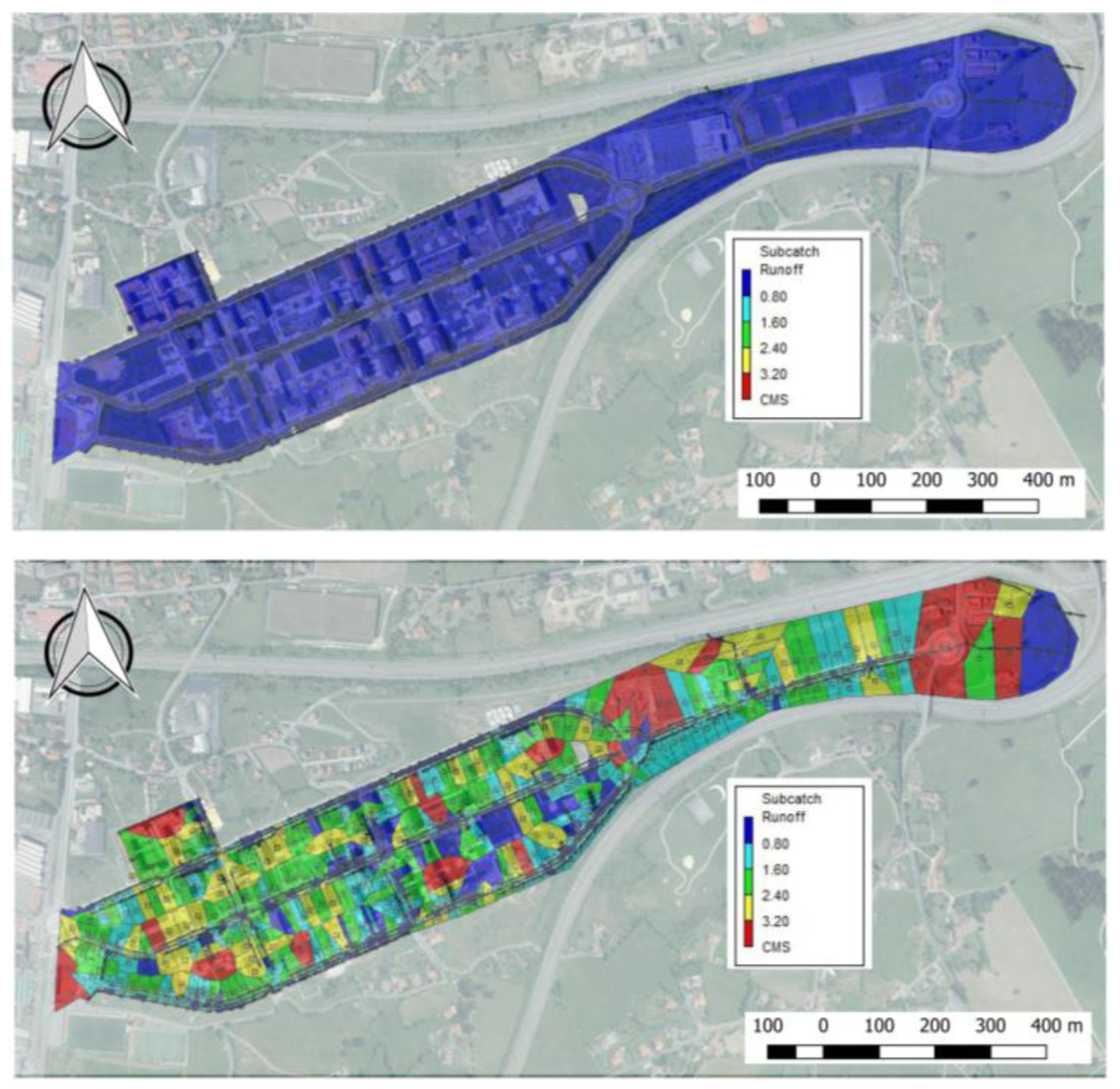
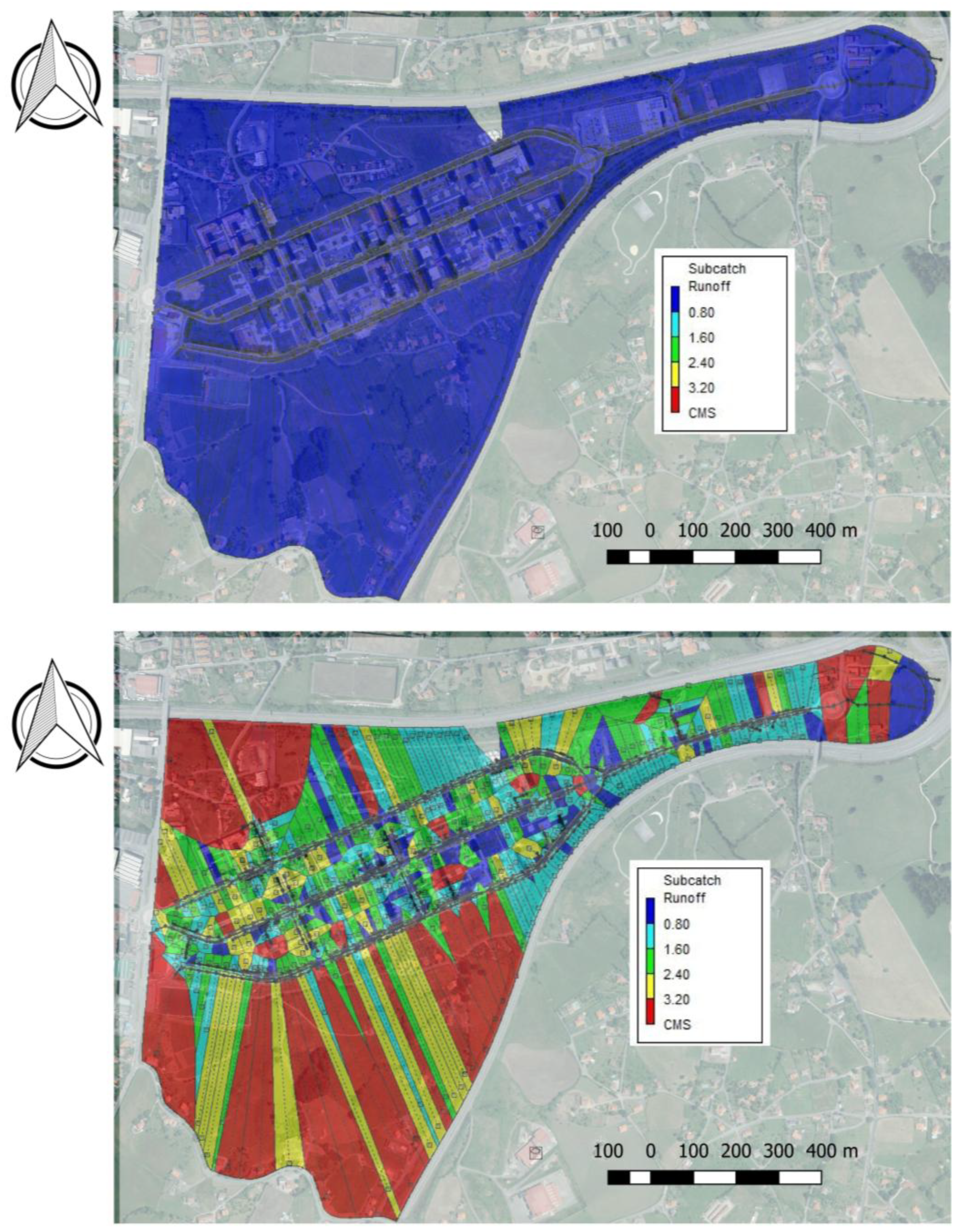
| Station Name | AEMET Reference | Longitude | Latitude | Altitude (m) | Range of Performance |
|---|---|---|---|---|---|
| Gijón La Merced | 1208A | 5°39′43″ W | 43°322L30″ N | 22 | 1 October 1938–31 May 1976 |
| Gijón | 1208 | 5°382L15″ W | 43°322L20″ N | 3 | 31 May 1976–5 April 2001 |
| Gijón Musel | 1208H | 5°412L55″ W | 43°332L39″ N | 5 | 5 April 2001–31 December 2011 |
| Maximum Daily Rainfall (mm) | Return Periods |
|---|---|
| 55.00 | 2.5 years |
| 68.69 | 5 years |
| 81.09 | 10 years |
© 2018 by the authors. Licensee MDPI, Basel, Switzerland. This article is an open access article distributed under the terms and conditions of the Creative Commons Attribution (CC BY) license (http://creativecommons.org/licenses/by/4.0/).
Share and Cite
Allende-Prieto, C.; Méndez-Fernández, B.I.; Sañudo-Fontaneda, L.A.; Charlesworth, S.M. Development of a Geospatial Data-Based Methodology for Stormwater Management in Urban Areas Using Freely-Available Software. Int. J. Environ. Res. Public Health 2018, 15, 1703. https://doi.org/10.3390/ijerph15081703
Allende-Prieto C, Méndez-Fernández BI, Sañudo-Fontaneda LA, Charlesworth SM. Development of a Geospatial Data-Based Methodology for Stormwater Management in Urban Areas Using Freely-Available Software. International Journal of Environmental Research and Public Health. 2018; 15(8):1703. https://doi.org/10.3390/ijerph15081703
Chicago/Turabian StyleAllende-Prieto, Cristina, Beatriz I. Méndez-Fernández, Luis A. Sañudo-Fontaneda, and Susanne M. Charlesworth. 2018. "Development of a Geospatial Data-Based Methodology for Stormwater Management in Urban Areas Using Freely-Available Software" International Journal of Environmental Research and Public Health 15, no. 8: 1703. https://doi.org/10.3390/ijerph15081703
APA StyleAllende-Prieto, C., Méndez-Fernández, B. I., Sañudo-Fontaneda, L. A., & Charlesworth, S. M. (2018). Development of a Geospatial Data-Based Methodology for Stormwater Management in Urban Areas Using Freely-Available Software. International Journal of Environmental Research and Public Health, 15(8), 1703. https://doi.org/10.3390/ijerph15081703







